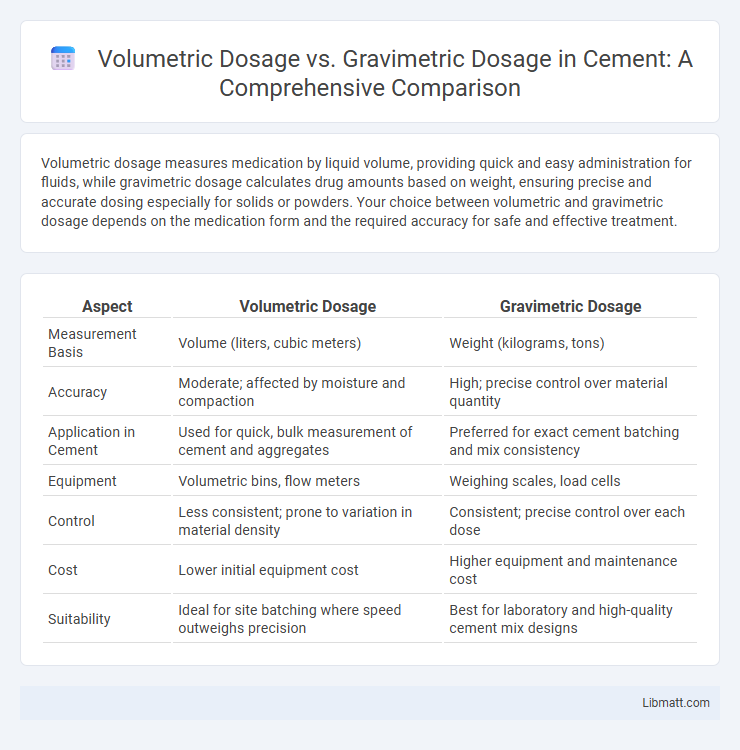Volumetric dosage measures medication by liquid volume, providing quick and easy administration for fluids, while gravimetric dosage calculates drug amounts based on weight, ensuring precise and accurate dosing especially for solids or powders. Your choice between volumetric and gravimetric dosage depends on the medication form and the required accuracy for safe and effective treatment.
Table of Comparison
| Aspect | Volumetric Dosage | Gravimetric Dosage |
|---|---|---|
| Measurement Basis | Volume (liters, cubic meters) | Weight (kilograms, tons) |
| Accuracy | Moderate; affected by moisture and compaction | High; precise control over material quantity |
| Application in Cement | Used for quick, bulk measurement of cement and aggregates | Preferred for exact cement batching and mix consistency |
| Equipment | Volumetric bins, flow meters | Weighing scales, load cells |
| Control | Less consistent; prone to variation in material density | Consistent; precise control over each dose |
| Cost | Lower initial equipment cost | Higher equipment and maintenance cost |
| Suitability | Ideal for site batching where speed outweighs precision | Best for laboratory and high-quality cement mix designs |
Introduction to Dosage Methods
Volumetric dosage measures medication based on liquid volume, commonly used for solutions and suspensions, ensuring quick and straightforward administration with devices like syringes or measuring cups. Gravimetric dosage relies on the precise weight of a substance, ideal for powders, solids, and formulations requiring high accuracy in active ingredient concentration, often measured using calibrated scales. Choosing between volumetric and gravimetric methods depends on the drug's physical state, required precision, and application context in pharmaceutical and healthcare settings.
Defining Volumetric Dosage
Volumetric dosage involves measuring medication by the volume of liquid administered, typically using units such as milliliters or cubic centimeters. This method is essential for accurately delivering liquid medications, especially in pediatric or intravenous treatments where precise volume control impacts therapeutic outcomes. Your understanding of volumetric dosage is crucial when differentiating it from gravimetric dosage, which calculates medication by weight, ensuring the correct approach for your specific medical or pharmaceutical needs.
Understanding Gravimetric Dosage
Gravimetric dosage involves measuring medication by weight, ensuring precise and consistent dosing critical in pharmaceuticals and laboratory settings. Unlike volumetric dosage, which relies on liquid volume and can be affected by temperature and density variations, gravimetric methods provide accuracy by directly quantifying mass through balances or scales. Implementing gravimetric dosage minimizes errors in formulation and administration, enhancing treatment efficacy and safety protocols.
Key Differences: Volumetric vs Gravimetric
Volumetric dosage measures liquid substances by volume using instruments like pipettes or graduated cylinders, ensuring quick and convenient measurement for fluids. Gravimetric dosage involves weighing substances with high precision scales, offering more accuracy and consistency, especially important in formulations requiring exact concentrations or powders. Your choice between volumetric and gravimetric dosage depends on the need for speed versus precision in your measurement process.
Accuracy and Precision Analysis
Volumetric dosage often shows variability due to factors like liquid density, temperature fluctuations, and meniscus reading errors, impacting its accuracy and precision. Gravimetric dosage provides superior accuracy and precision by measuring the actual mass of the substance, eliminating density and volume-related inconsistencies. Analytical laboratories prefer gravimetric methods for critical formulations requiring stringent dosage control and reproducibility.
Application Scenarios in Industry
Volumetric dosage is commonly used in industries where liquid measurement and speed are critical, such as pharmaceuticals and food processing, allowing precise volume control for solutions and suspensions. Gravimetric dosage, preferred in chemical manufacturing and materials science, offers higher accuracy by measuring the mass of substances, essential for formulations requiring exact compound ratios. Your choice between these methods depends on the application's precision requirements, material properties, and operational efficiency.
Equipment and Technology Involved
Volumetric dosage relies on equipment such as graduated cylinders, pipettes, and burettes that measure liquid volumes precisely through calibrated markers, while gravimetric dosage uses high-precision balances and scales to determine the exact mass of substances. Advanced technologies like digital mass flow meters and automated dosing systems enhance accuracy in gravimetric methods, reducing human error in weighing and improving reproducibility. Choosing the right equipment for your application depends on whether volume consistency or mass accuracy is critical for your dosage process.
Pros and Cons of Each Dosage Method
Volumetric dosage offers rapid and convenient liquid measurements, ideal for solutions with consistent density, but its accuracy can be compromised by temperature fluctuations and liquid viscosity variations. Gravimetric dosage provides highly precise mass-based measurements resistant to environmental changes, making it suitable for formulations requiring exact dosing, though it demands more complex equipment and longer preparation times. Choosing between volumetric and gravimetric dosing hinges on balancing the need for speed and convenience against measurement accuracy and process control.
Factors Influencing Dosage Method Selection
Factors influencing the selection between volumetric dosage and gravimetric dosage include the precision required, the physical properties of the substance, and the environmental conditions during measurement. Gravimetric dosage offers higher accuracy by measuring mass directly, making it ideal for substances with variable density or moisture content. Your choice depends on balancing accuracy needs with operational efficiency and the nature of the material being dosed.
Future Trends in Dosage Technologies
Future trends in dosage technologies emphasize the integration of automation and precision measurement, favoring gravimetric dosage methods for their accuracy and consistency in drug delivery. Advanced sensors and AI-driven systems enhance volumetric dosage by compensating for fluid density fluctuations, improving reliability in pharmaceutical manufacturing. Your ability to select the appropriate dosage technique will increasingly depend on balancing speed, accuracy, and technological innovation in evolving healthcare environments.
Volumetric Dosage vs Gravimetric Dosage Infographic

 libmatt.com
libmatt.com